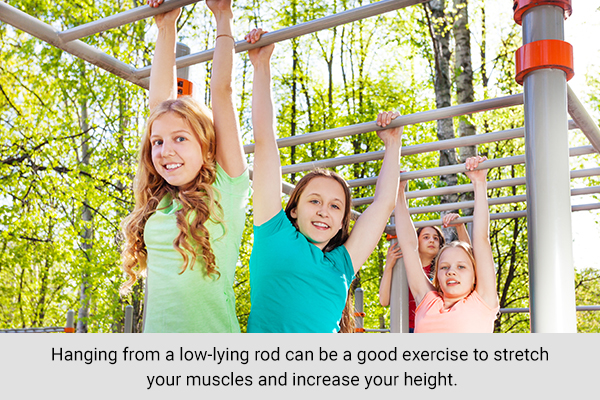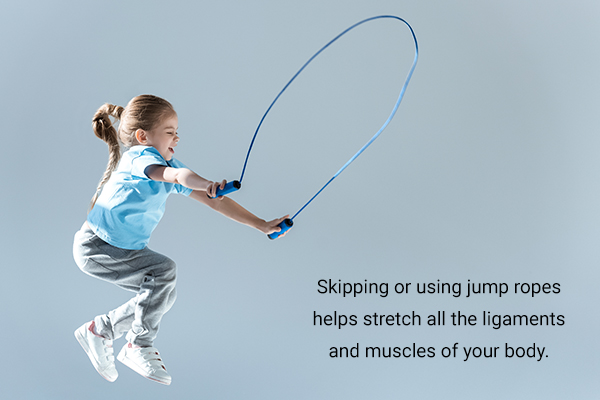Your height, like most other physical traits, is determined by a number of different factors. Genes, nutrition, environment, etc., all play roles in how tall you grow.

Most girls attain their maximum height by 15–18 years of age, whereas boys can grow up to 21 years of age. (1)
If you are a teenager looking for ways to get taller, there are a few tips that may be helpful for you. Read on to take a look at them.
Tips to Increase Your Height
Although there are some ways to help boost growth and hopefully height, you should remember that more than 60% of your height is determined by your genetics – so do not expect magical results!
Yet, they may help you add a couple more inches and help you grow into your maximum height potential.
1. Consume ashwagandha
Ashwagandha root extract is an ancient Ayurvedic remedy that boosts the levels of growth hormones in the body.
Ashwagandha contains flavonoids, steroidal lactones, antioxidants, and other important plant compounds. It also mimics the neurotransmitter GABA that helps increase the production of human growth hormone in the body. (2)
Consuming ashwagandha extract together with a nutritious diet can help you grow taller.
You can mix a couple tablespoons of ashwagandha powder into a glass of milk and drink it daily, or consume ashwagandha capsules, which are readily available.
2. Exercise regularly

Exercise and other physical activity may help induce a growth spurt in adolescents.
Here are a few exercises you can try:
a. Hanging exercise
Hanging from a low-lying rod (about the height of your doorframe) can be a good exercise to stretch your muscles and increase your height.
Get a rod fixed at the entrance of a room and grab it with your hands. Hang in there for a few minutes every day.
b. Stretching
Leaning against the wall and stretching your hand above your head is another easy exercise to stimulate growth. Stand on your toes and stretch your body as far as you can for maximum benefit.
c. Skipping

Skipping helps bend your knees back and forth. This may help stimulate growth in some people.
Skipping or using jump ropes helps stretch all the ligaments and muscles of your body. It can help you lose weight, and a leaner body makes you appear taller. It can also make your bones stronger, giving you good height.
d. Yoga
Certain yoga asanas are associated with growth in height. The cobra pose and the triangle pose are some common examples.
e. Toe touching exercise
Stand on your feet and try to touch your toes without bending your spine. This is an easy and effective exercise that may help induce growth.
f. Swim
Swimming for a couple of hours every day is an excellent workout that can stretch all your muscles. It boosts muscle growth and strength in teenagers.
3. Change your diet
Consuming food abundant in nutrients that boost growth, such as protein, calcium, and vitamin D, is perhaps the most effective way to grow your height. Teenagers and children need the right nutrients to help their bones and muscles grow to their maximum potential.
Milk, eggs, meat, chickpeas, cheese, pulses, etc., are all rich sources of nutrients necessary for good height. (3)(4)
4. Get adequate sleep

A proper sleep routine is essential for growth. Several hormones that regulate body functions such as growth and metabolism are released during sleep.
Most teenagers need at least 7 hours of uninterrupted sleep every night. (5)
5. Observe proper posture
Bad posture due to excessive use of cell phones is a common problem among children and young adults today. It is common knowledge that a bad posture can make you look shorter or “bent down.”
Here are a few tips to improve your posture:
- Always keep your head straight looking forward (without putting a strain on your neck; let it rest naturally).
- Tuck your shoulder blades down instead of drooping at the front.
- When using an electronic device (cell phones, tablets, laptops, etc.), raise the device to eye level instead of bending your neck and shoulders to view the screen.
6. Keep your body hydrated
Water helps flush out toxins from the body and assists in metabolic activities. It is necessary to drink 2 liters of water every day to help increase metabolism, which may help induce growth.
7. Stay active
Staying active is essential for a healthy life, and cultivating this habit during your teenage years may help you stick to it for life.
Physical activity has been shown to increase human growth hormone levels in children and adolescents. It also helps increase the absorption of minerals by the bones.
An active lifestyle also decreases your chances of becoming overweight.
Final Word
Most of your height comes from hereditary factors and cannot be changed. Yet, you can make some changes to your lifestyle to achieve a taller body in your growing years as, after 21 years of age, it is not anymore possible to increase your height.
- Was this article helpful?
- YES, THANKS!NOT REALLY


